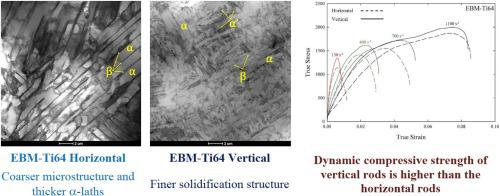Additive Manufacturing ( IF 11.0 ) Pub Date : 2020-05-26 , DOI: 10.1016/j.addma.2020.101347 Reza Alaghmandfard , Dharmendra Chalasani , Amir Hadadzadeh , Babak Shalchi Amirkhiz , Akindele Odeshi , Mohsen Mohammadi

|
Cylindrical rods of Ti–6Al–4V (Ti64) alloy were additively produced using the electron beam melting (EBM) process in the horizontal and vertical directions. Optical microscopy, electron microscopy (scanning and transmission), X-ray diffraction (XRD), and electron backscatter diffraction (EBSD) techniques were employed to characterize the microstructure and phases of the EBM–Ti64 alloy. The microstructure consists of α and β phases, where in the vertical sample, the average α-width decreased, and the finer microstructure was formed. Both horizontal and vertical samples were subjected to several dynamic compression tests at various strain rates between 150 s−1 and 1100 s−1 using a Split-Hopkinson pressure bar apparatus to characterize the effect of the build direction. Peak stress increased with the increase in strain rate for both orientations. The dynamic compressive strength of the alloy in both directions was strain-rate dependent, where the maximum of 1880 MPa and 2000 MPa was attained for horizontal and vertical samples, respectively. Under similar loading conditions, the strength of the vertical specimens was consistently higher than that of the horizontal ones. This was attributed to the finer microstructure and near-parallel orientation of prior β-boundaries to the impact loading axis in the vertical samples. Furthermore, a constitutive mathematical model was developed to encompass the results of dynamic flow curves for both directions to interpret the elevated strain rate behavior of EBM–Ti64. Model predictions were in good agreement with the experimental data.
中文翻译:

高应变速率下电子束熔化的Ti-6Al-4V的动态压缩响应:微观结构和本构模型
使用电子束熔化(EBM)工艺在水平和垂直方向上添加了Ti-6Al-4V(Ti64)合金圆柱棒。光学显微镜,电子显微镜(扫描和透射),X射线衍射(XRD)和电子反向散射衍射(EBSD)技术用于表征EBM-Ti64合金的微观结构和相。微观结构由α相和β相组成,在垂直样品中,平均α宽度减小,形成了更精细的微观结构。水平样品和垂直样品均在150 s -1至1100 s -1之间的不同应变率下进行了几次动态压缩测试使用Split-Hopkinson压力杆设备来表征构建方向的影响。在两个方向上,峰值应力都随着应变率的增加而增加。合金在两个方向上的动态抗压强度都取决于应变率,水平和垂直样品的最大抗压强度分别达到1880 MPa和2000 MPa。在相似的载荷条件下,垂直试样的强度始终高于水平试样的强度。这归因于垂直样品中先前的β边界相对于冲击载荷轴具有更好的微观结构和接近平行的取向。此外,建立了本构数学模型以包含两个方向的动态流动曲线结果,以解释EBM-Ti64的应变率行为升高。



























 京公网安备 11010802027423号
京公网安备 11010802027423号